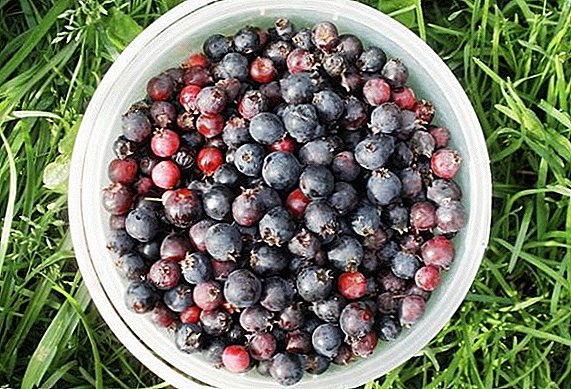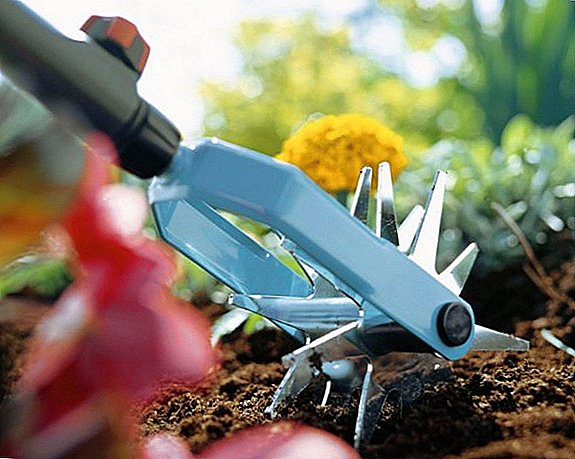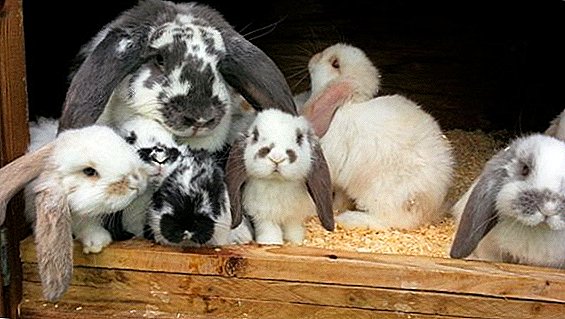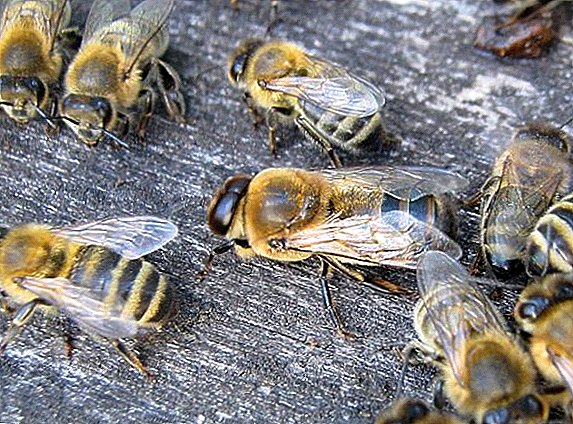 For people who know about beekeeping by hearsay, it is difficult to understand what a drone is and why it is needed in a bee swarm. Many people know only the unpleasant side of its existence: the drone does not do anything in the hive, but it eats for five. Nevertheless, in each swarm, nature provides for the existence of several such individuals. Why do they need them, what does a drone look like and what is the meaning of their existence?
For people who know about beekeeping by hearsay, it is difficult to understand what a drone is and why it is needed in a bee swarm. Many people know only the unpleasant side of its existence: the drone does not do anything in the hive, but it eats for five. Nevertheless, in each swarm, nature provides for the existence of several such individuals. Why do they need them, what does a drone look like and what is the meaning of their existence?
Important! Sometimes a bee drone is confused with a tinder bee. These are completely different individuals. First of all, they differ in sex. The drone is a male, the tinder is a female. It develops from the bees that feed the queen. If she dies or weakens, they begin to feed each other with bee milk, and some develop into egg-laying females. However, the eggs laid by them, not fertilized by the male, because of them can only hatch underdeveloped drones. The fact is that such bees are not physiologically able to mate with the drone and fertilize these eggs. Therefore, one must always ensure that there is a queen in the swarm.
Who is the drone: a description of the appearance of the bee male
So, let's see what kind of drone a bee has and what it is. The drone is a male bee whose task is to fertilize the eggs of the uterus. Accordingly, its appearance is strikingly different from both the queen herself and the worker bees. This insect is noticeably larger than the usual bee. In length reaches 17 mm, and weighs about 260 mg. 
Did you know? Drones fly out of the hive no earlier than noon, less often in the evening. Their flight is distinguished by a bass sound, and upon arrival the drone is lowered onto the flight board with a characteristic heavy sound, as if falling from exhaustion.It has well developed wings, huge eyes, but a small honey proboscis. So small that outside the hive a drone can not feed itself. He doesn’t have brushes with which bees collect pollen, he has not developed scallops and baskets in which pollen is carried. Bees do not have glands that are involved in the formation of bee milk and wax. He has no sting, so the insect is completely defenseless.
He has well developed only those parts of the body that help to perform the functions entrusted to him by nature - mating with the female. Excellent vision, smell, high speed of flight - these are the main advantages. They live a short time, from May to August, but during this time one drone has time to eat four times the usual bee.
What role does the drone in the bee family, functions and purpose
The logical question arises, why do we need drones in the hive, if they do not produce anything, are incapable of taking care of themselves and at the same time absorb more of those individuals that benefit? It should be understood that these insects carry the genetic material of the entire genus, they are the only ones who can fertilize the uterus. 
Did you know? The drones, who are sons of the womb, keep an exact copy of its genome. Each male has 16 chromosomes, while the uterus - 32. This discrepancy occurs because the drone comes from an unfertilized egg, that is, the bees have no male heredity.The drone bee is ready to mate after two weeks from the moment it hatches from the honeycomb. Mating with the uterus does not occur in the hive, but outside, and during the flight. That is why his nature endowed with good eyesight and flight reactivity. In search of females, the drone takes off around lunchtime and makes three sorties per day. Returns always before sunset. In flight the insect can be up to half an hour. When the queen bee is found and caught, the drone mates with it in flight for about 23 minutes.
Another function of the drone is to maintain thermoregulation in the nest. When the cold comes, and the drones are not expelled from the hive, they are knocked around the eggs, warming them with their heat.
Did you know? The number of drones remaining in the autumn speaks about the performance of the uterus. The more of them, the performance is lower. This is a signal that it is necessary to take appropriate measures.
If a masculine bee stayed in the hive for the winter, in the spring it would not live long anyway. She is experiencing bad cold, weakens and a maximum of a month after the beehive is exposed dies. And the presence of a hibernating drone indicates that the uterus is old and barren, or she has died altogether.
Features of the life cycle of the drone
The drones hatch from the unborn eggs of the queen's swarm. It happens on the 24th day after laying. Three days before this, worker bees are born, and eight are young queen bees.  Cells with larvae of drones are located on the perimeter of the honeycomb. If there is not enough space, working bees finish them on the honeycomb bee cells. In total, about 400 drones are grown in one family, but the number of these insects sometimes exceeds a thousand.
Cells with larvae of drones are located on the perimeter of the honeycomb. If there is not enough space, working bees finish them on the honeycomb bee cells. In total, about 400 drones are grown in one family, but the number of these insects sometimes exceeds a thousand.
At the beginning of May, the drone leaves the cell, and for about 10 days the bees actively feed it, ensuring the correct formation of the insect's organism. From about the seventh day, the male starts the first flights in order to familiarize himself with the environment. And only two weeks later, he flies out for a specific purpose - the search for a female to mate.
Did you know? The female drone finds, catching in the air uterine substance. At the same time he can distinguish him only at a considerable distance and at a height of more than 3 m above the ground, and the closer he flies to the female, the more he relies on his sight. The inability to catch the pheromone at close range explains why mating does not occur in the hive.
 There he has to fight for the right to leave his seed to her, so weak individuals are sifted out and only those bee drones that carry the strongest genetic material in their somatic cells remain. For fertilization of the female, about 6-8 males are required. All of them, having fulfilled their purpose, perish in a short time.
There he has to fight for the right to leave his seed to her, so weak individuals are sifted out and only those bee drones that carry the strongest genetic material in their somatic cells remain. For fertilization of the female, about 6-8 males are required. All of them, having fulfilled their purpose, perish in a short time.Before performing their duty, the drones live in the same bee swarm. But, flying out of their hive, they can count on the help of bees from other families. They are not chased away and always fed because they know who the drone is and that he can become a partner of their womb.
How much a drone will live depends on many factors: whether there is a womb in the swarm, how much it is capable of fertilization, what a general condition of the family is. Much depends on weather conditions. But on average they live for about two months.
Important! Sometimes, in order to preserve the volume of honey, beekeepers cut off cells with drones on comb. But this is a dubious move, as working bees will still take care of the required number of drones, completing new cells for them. A more effective way is to ensure that the uterus in the hive is no older than two years. Then they will produce less drones.
 Drones in the bee colony are the most important food absorbers. Therefore, as soon as the amount of nectar is reduced, worker bees throw out cells with non-hatched brood, and no longer feed adult drones, pushing them away from honeycombs. After two or three days, when they become weak from hunger, they are driven out of the hive. Since they are not able to feed themselves and take care of themselves in general, they quickly die. However, if the uterus stopped laying eggs or the swarm was left without it at all, the drones remain in the hive as keepers of genetic material. These same reasons are the only way to escape the exiled drones. If they quickly find a hive without a uterus, they will be happy to be accepted into a new family.
Drones in the bee colony are the most important food absorbers. Therefore, as soon as the amount of nectar is reduced, worker bees throw out cells with non-hatched brood, and no longer feed adult drones, pushing them away from honeycombs. After two or three days, when they become weak from hunger, they are driven out of the hive. Since they are not able to feed themselves and take care of themselves in general, they quickly die. However, if the uterus stopped laying eggs or the swarm was left without it at all, the drones remain in the hive as keepers of genetic material. These same reasons are the only way to escape the exiled drones. If they quickly find a hive without a uterus, they will be happy to be accepted into a new family.Drones in the bee family: all the pros and cons
In fact, it is difficult to say who is the most important in the bee colony. On the one hand, the reproduction of the genus depends on the uterus, but on the other hand, if there were no drone in the swarm, there would be no swarm itself. After all, it consists of working bees, which can be born only from fertilized eggs. Therefore, weighing the pros and cons is not entirely appropriate. Yes, they are essentially ruining the stocks of bees. Considering that one such insect is for four, knowing what the drone eats, each beekeeper understands with regret the size of his losses. But we must understand that without these losses there would be no honey at all. In addition, the destruction of stocks of honey - the only drawback of the presence of drones in the family.
Did you know? To feed a kilogram of drones, 532 g of honey is consumed per day, 15.96 kg per month, and almost 50 kg of honey for the whole summer. In a kilogram of drones, there are about 4 thousand individuals.But there are additional benefits. In the autumn, when it comes time to expel drones, one can judge the state of the family. Knowing what the drone looks like, it is enough to count the number of their corpses around the hive. If there are a lot of them - everything is in order with a swarm; In addition, these insects sometimes help to preserve the future population of workers swarming bees. When the air temperature becomes noticeably low and jeopardizes the viability of the larvae, they pile up at the cells, warming the larvae with their large and powerful bodies. Actually, this explains all the explanations of who the drone is in bees, what are its advantages and disadvantages.
Drones: Basic Questions and Answers
Often, when studying such a phenomenon in the hive as drones, many have additional questions. Next, we will try to answer the most typical.
Why after mating drone loses viability?
For mating, the male bee releases the insemination organ, which previously was located inside its body. This process follows the principle of turning it inside out, when the inner walls become external. At the end of the process, the onion of the penis organ is also inverted. The organ itself has horns curved downwards at the ends. Having loaded it into the chamber of the sting of the uterus, the male penetrates the aggregate pockets with its horns, leaving his sperm in them. As soon as the male's sexual organ is completely twisted, the drone dies.
Did you know? Drones fly behind the uterus in a large swarm. The first, having overtaken her, copulates in flight and immediately dies. Then she is overtaken by another. So they change until the uterus finishes mating. Some drones twist the organ before reaching the uterus, and also die right on the fly.Is it possible, looking at the drone, to determine the breed of bees?
Of course. For example, Caucasian mountain bees have black drones, while worker bees are gray. The Italian breeds have reddish drones, while the central Russian woods have dark-red.
What qualities does the drone transmit to the offspring?
 We remember that male bees appear from unfertilized eggs, that is, they have the makings of only maternal ones. Therefore, the offspring will be strong if the uterus is prolific, the bees are efficient, peaceful, collect a lot of nectar and tolerate wintering well. If the family cannot boast of such qualities, it is recommended to change the uterus more often, as well as to regulate the number of drone brood: use drones, cut the brood brood every two weeks. But it is important here and not to overdo it, destroying all the males - this greatly weakens the family.
We remember that male bees appear from unfertilized eggs, that is, they have the makings of only maternal ones. Therefore, the offspring will be strong if the uterus is prolific, the bees are efficient, peaceful, collect a lot of nectar and tolerate wintering well. If the family cannot boast of such qualities, it is recommended to change the uterus more often, as well as to regulate the number of drone brood: use drones, cut the brood brood every two weeks. But it is important here and not to overdo it, destroying all the males - this greatly weakens the family.
Having understood the name of the male bee, what is its purpose in the hive, and what is its life cycle, you can forgive him for the losses incurred by the beekeeper when the male bees feed the workers bees. After all, they save the bee colony from degeneration, keep its genes, help to keep warm around the larvae of working bees. All this speaks of the great importance of drones in the life of the hive.












